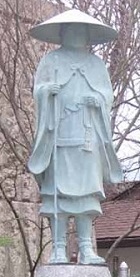History of Jodo Shinshu Buddhism
 There are several sects of Buddhism each looking to the Buddha (Enlightened One) as its teacher. Different Buddhist sects celebrate Buddha’s teachings through different practices.
There are several sects of Buddhism each looking to the Buddha (Enlightened One) as its teacher. Different Buddhist sects celebrate Buddha’s teachings through different practices.
The historical Buddha, Siddhartha Gautama, lived about 566 to 486 BC. At 35, he gained insight into the true nature of existence. The next 45 years, until his death at age 80, Siddhartha, who is also referred to Shakyamuni Buddha, taught the answers to humans’ inescapable problems—such as death, old age, sickness and separation from loved ones.
The Buddha’s teachings focus on understanding human problems through insight into the changing nature of existence. They are not based on authority, doctrines, creeds and beliefs in anything supernatural. Rather, everything is explained by causes and conditions that are continuously changing in the law of impermanence.
Shin Buddhism: The Path of Gratitude and Humility
One of the most compelling paths of Buddhism is the Jodo Shinshu, or Shin, Buddhist path—the path of gratitude and humility. While other schools of Buddhism seek to “attain” or “realize” enlightenment, the Shin Buddhist path is one of simply listening and opening one’s heart to receiving it. The pursuit of enlightenment can become something like chasing after a mirage in the desert: You think you have arrived, only to find it has disappeared.
Trying to grasp at or attain enlightenment can be like trying to grab a snowflake that falls. Once you grab it, you have crushed it. But if you open your hand and allow the snow to gently fall into your hand, the snowflake becomes yours, without any effort in grasping.
Rather than pursuing enlightenment, we simply listen to the Dharma and receive it.
Simply listen
This is the Shin Buddhist path. Rather than pursuing enlightenment, we simply listen to the Dharma and receive it, and allow it to unfold into our hearts and minds. This does not require any particular lifestyle. You don’t have to become a monk or sit for hours in meditation. You can listen to the Dharma in your everyday life, no matter what you do or where you are.
Listening to the Dharma can mean listening to a sermon or lecture, but it can also mean listening or talking to anyone. You never know who might be your teacher of the Dharma, if you have the ears and heart to listen. A taxi driver could be a teacher, or a bartender, or your worst enemy.
Shakyamuni taught that we live lives characterized by difficulties. These difficulties result from our inability to see things as they are. Our preferences and prejudices influence how we see and engage the world resulting in difficulties for ourselves and others.
The resolution of difficulties through cultivating a mind that sees things as they are is the Buddha Dharma.
Shinran Shonin, who founded Shin Buddhism in the 1200s in Japan, lived a life as a monk for 20 years, but could not find enlightenment in that setting or environment. He saw himself as being mired in his own foolishness, bound to the continued experience of difficulties. But he met a wonderful teacher, named Honen, who was teaching that the Dharma can be received whether one is a monk or lay person. The lifestyle did not matter as much as having the right attitude in listening and receiving the teaching. Honen taught Shinran that the Dharma is “received,” and that we must simply open our hearts and minds to it in gratitude.
Shinran found hope in the Vow of Amida Buddha, which assures all beings of the resolution of difficulties. The assurance of Amida allows us to see our own foolishness. With a deepening awareness of our foolishness, we live with gratitude for the assurance of Amida.
Shinran discovered this way of gratitude, the way of humility, through Honen’s compassionate teaching. Then the light of the Dharma began to permeate his heart and mind, illuminating and penetrating into even the darkest corners of his ego self.
The true strength of life
The life of humility is the most powerful and dynamic life. In the West, we think humility means being weak or passive, but humility is the true strength of life.
We think that an oak tree is tall and firm, but in a strong wind, the oak tree breaks. A willow or bamboo, however, is soft and flexible, and can bend and not break in a strong wind. A humble person is truly strong, whereas a rigid, stubborn person is actually weak.
The life of other’s sacrifices
When we begin to look at life from the perspective of the recipient, then everything in life is a gift—what we know, what we own, what we have achieved. They are all in a sense gifts, because nothing can be accomplished on one’s own. The successful businessman is successful because of his customers, because of his employees, because of his business knowledge that he has learned from others. The Olympic Gold Medalist, of course, trains and accomplishes an amazing athletic feat. But, in reality, it would not have been possible without coaches and teammates, family and supporters.
The Shin Buddhist way of life is the life of unending gratitude. The more one becomes grateful, the more one becomes humble. The more one becomes humble, the less one needs in life. The less one needs in life, the more one truly has.
Some content courtesy of Buddhist Churches of America

